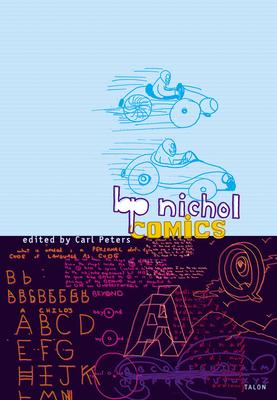The scope, innovation and depth (down to the heart) of bpNichol's writing makes him one of the most important writers in English of the 20th century. He is widely known for his research into genres as diverse as the lyric, the long poem, sound poetry, concrete poetry, critical theory and now, with the publication of bpNichol Comics, we can even add the comic strip to this impressive list.
Carl Peters has put together this major collection of Nichol's comics from 1960 to 1980, which frame characters ranging from Milt the Morph, to Bob de Cat, Lonely Fred and Rover Rawshanks: rich examples of Nichol's attempts to explode conventional syntax, narrative structure, lyric self-centredness-indeed all of the conventions of modernist art and art making. And with the inclusion of a remarkable selection of previously unpublished letters and essays around the comics themselves, Peters shows us that Nichol's comics informed not only his own work in other genres, but the work of other writers as well. But, in as much as Nichol's comics bring us to a deeper understanding of his poetics, his comics also remind us that, as Robin Blaser writes, "the truth is laughter." bpNichol Comics is not only for scholars, poets, cartoonists, artists, animators, writers and readers; it is for the inquisitive and adventurous child in all of us.
The scope, innovation and depth (down to the heart) of bpNichol's writing makes him one of the most important writers in English of the 20th century. He is widely known for his research into genres as diverse as the lyric, the long poem, sound poetry, concrete poetry, critical theory and now, with the publication of bpNichol Comics, we can even add the comic strip to this impressive list.
Carl Peters has put together this major collection of Nichol's comics from 1960 to 1980, which frame characters ranging from Milt the Morph, to Bob de Cat, Lonely Fred and Rover Rawshanks: rich examples of Nichol's attempts to explode conventional syntax, narrative structure, lyric self-centredness-indeed all of the conventions of modernist art and art making. And with the inclusion of a remarkable selection of previously unpublished letters and essays around the comics themselves, Peters shows us that Nichol's comics informed not only his own work in other genres, but the work of other writers as well. But, in as much as Nichol's comics bring us to a deeper understanding of his poetics, his comics also remind us that, as Robin Blaser writes, "the truth is laughter." bpNichol Comics is not only for scholars, poets, cartoonists, artists, animators, writers and readers; it is for the inquisitive and adventurous child in all of us.Paperback
$24.95